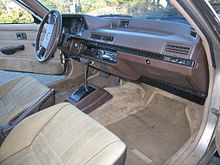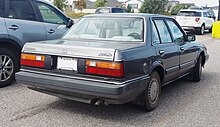
HONDA ACCORD SECOND GENERATION (1981-1985)
Debuted on 22 September 1981, in Japan, Europe and North America, this generation of the Accord being produced in Japan, also became the first to be built in the United States, at Honda's plant in Marysville, Ohio. Since its first year in the American market, it also became the best-selling Japanese nameplate in the United States, retaining that position for about 15 years.In Japan, a sister model called the Honda Vigor was launched simultaneously with the new Accord. This allowed Honda to sell the product at different sales channels called Honda Clio, which sold the Accord, and Honda Verno, that sold the Vigor.
Modernizing the interior and exterior, the second-generation Accord was mechanically very similar to the original, using the same 1,751 cc (1.751 L; 106.9 cu in) EK-1 CVCC engine in the Japanese market. Vehicles with a manual transmission and the CVCC carburetor earned 13.6 km/L (38 mpg‑imp; 32 mpg‑US) based on Japanese Government emissions tests using 10 different modes of scenario standards, and 110 PS (81 kW; 108 bhp), and 23 km/L (65 mpg‑imp; 54 mpg‑US) with consistently maintained speeds at 60 km/h. European market cars received the tested 1.6-liter EL1 engine with 80 PS (59 kW; 79 bhp) at 5000 rpm.This automobile included popular features of the time such as shag carpet, velour cabin trim, and chrome accents. An optional extra on the 1981 Accord was an Electro Gyrocator, the world's first automatic in-car navigation system. Models were available in Silver, Sky Blue, and Beige. The LX hatchback offered a digital clock and slightly higher fuel economy (due to its lighter weight). In Europe, the Accord was available as a fairly well equipped (for the time) standard version, as well as a very luxurious EX model at a modest upcharge.[24]
In the United States, Federal lighting regulations required headlamps of sealed beam construction and standard size and shape on all vehicles, so Accords in North America were equipped with four rectangular headlamp units rather than the aerodynamic composite replaceable-bulb units used on Accords sold outside North America (note European specification imagery). Other Automotive lighting variations included amber front and red rear side marker lights and reflectors in North America, and headlamp washers and a red rear fog lamp for European markets. Japanese-market Accords were unique from all other markets in that they offered adjustable ride height control and side view mirrors installed on the mid-forward fenders.
In November 1982, Honda made a fully four-speed automatic available with the 1.8-liter engine, a major improvement over the earlier, three-speed semi-automatic "Hondamatic" transmission. This quickly filtered through to export markets, where the outdated Hondamatic was soon superseded entirely. The manual five-speed transmission remained unchanged. A new 120 mph speedometer replaced the earlier 88 mph unit. The Special Edition (SE) featured Novillo leather seating, power windows, power sunroof and door locks. Gray was added as a color option. A slightly modified EK-2 engine was introduced, replacing the earlier EK-1, albeit still carbureted.
1983 refresh
By 1983, Accords sold in the eastern United States were produced at the new Marysville plant, with quality considered equal to those produced in Japan. In June 1983, for the 1984 model year, the Accord body was restyled with a slightly downward beveled nose and a new series of 12-valve CVCC powerplants.[27] Globally there was a 1.6 (EY) and also the slightly more powerful ES2 1,829 cc (1.829 L; 111.6 cu in), yielding 86 bhp (64 kW) in federal trim. Honda integrated rear side marker lights and reflectors into the side of the tail light units. European Accords now included a side turn signal repeater just behind each front wheel well. The U.S. requirement for standardized headlamps was rescinded in late 1983, but North American Accords continued to use sealed beams until the fourth-generation models were released in 1989.
The LX offered velour upholstery, auto-reverse cassette stereo, air conditioning, cruise control, power brakes, power steering, power windows and power door locks (sedan only), a digital clock, roof pillar antenna, along with thick black belt moldings, integrated bumpers and flush plastic mock-alloy style wheels covers that resembled the trend-setting Audi 5000. Supplies were tight, as in the Eastern states, the wait was months for a Graphite Gray sedan, a then-popular color. The LX hatchback was the only 1984 version of the Accord to include dual side view mirrors.
The 1984 sedan was available in four exterior colors, Greek White and three metallic options: Columbus Gray, Regency Red (burgundy), and Stratos Blue (steel). The regular hatchback was available in Greek White, Dominican Red, and the metallic Stratos Blue. The 1984 LX hatchback came in three metallic colors only: Graphite Gray, Regency Red, and Copper Brown.
It was one of the first Japanese engineered vehicles to offer computer controlled, fuel-injection with one injector per cylinder, also known as multiple port fuel injection. This arrived on 24 May 1984 on the ES series 1.8 L engine, and was known as Honda's Programmed Fuel Injection, or PGM-FI.[28] This option was not offered until 1985 in the United States market. Vehicles with PGM-FI (ES3 series engine) earned 13.2 km/L (37 mpg‑imp; 31 mpg‑US) based on Japanese Government emissions tests using 10 different modes of scenario standards, with 130 PS (95.6 kW; 128.2 bhp), and 22 km/L (62 mpg‑imp; 52 mpg‑US) with consistently maintained speeds at 60 km/h (37.3 mph).
In 1985, the Special Edition returned as the SE-i, capitalizing on the final year of the second generation's production. A fuel-injected, 110 bhp (82 kW) non-CVCC ES3 engine was exclusive to this model. The moniker, SE-i, was adapted from the SE trim, but included the "-i" to signify the higher trim level's fuel-injected engine. This 12-valve, 1,829 cc (1.829 L; 111.6 cu in) engine was the first non-CVCC engine used in an Accord, and was the same basic engine design used by Honda until 1989. Like the previous SE trim in 1983, the SE-i featured Novillo leather seating, power moonroof, bronze tinted glass, a premium sound system with cassette, and 13-inch alloy wheels. The level of luxury equipment on the SE-i was essentially items that were installed on the Honda Vigor VTL-i, that was only sold in Japan.
Available options differed from market to market. The 1.8-liter engine, updated four-speed automatic transmission, and 'EX' trim level options were first made available in New Zealand during the 1984 model year refresh alongside the 1.6-liter 'LX' model.
Japan generally received more options earlier than the rest of the world. In 1981, the Accord offered an adjustable ride height air suspension in the Japanese market. From 1983 in Japan and 1984 in Europe, the second-generation Accord was available with anti-lock brakes (called ALB) as an option. This braking system was the first time that an Accord used four-wheel disc brakes. Fuel injection became available in 1984 in the Japan market with the earlier introduction of the ES3 engine in the SE-i. Models took a year to arrive in North American and European markets with less stringent emissions laws continuing, using carburetors throughout second-generation producti




















0 Comments